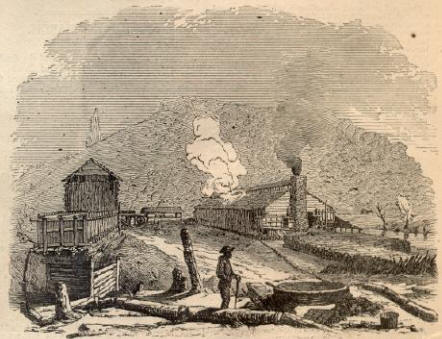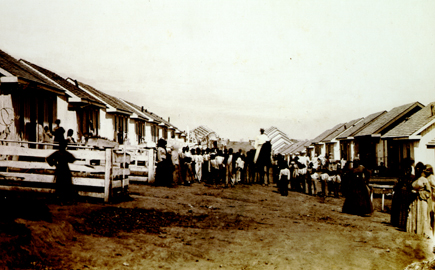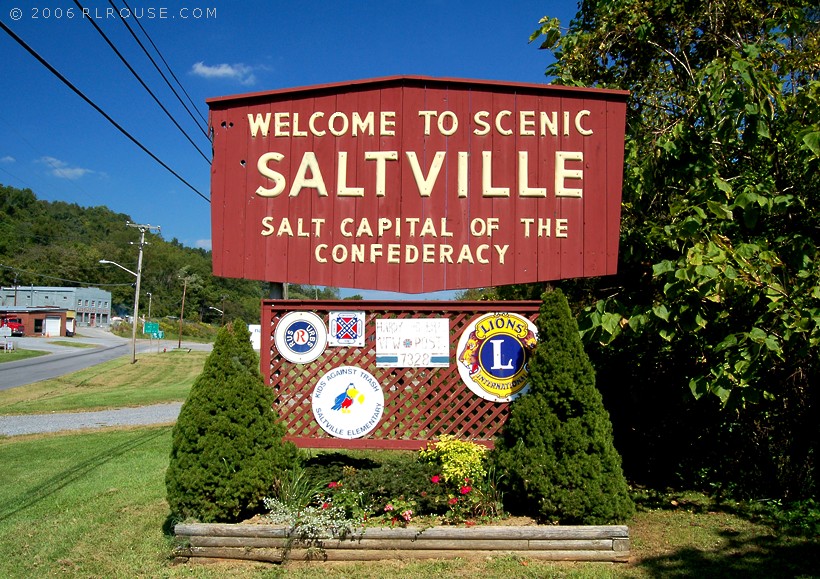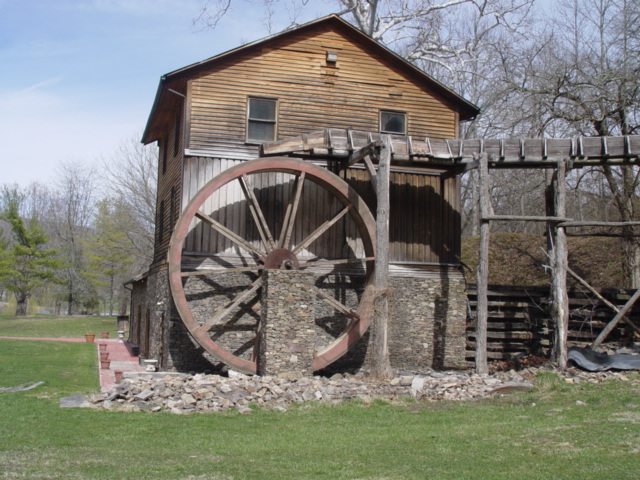
The Saltville Massacre
From the Confederate Salt Company -- On October 3,1864 there was a massacre of black Union soldiers on Chestnut Ridge in Saltville, Virginia. The exact count of the dead remains unclear. Estimates range from 26-100. The unfortunate men of the 5th U.S. Colored Cavalry were slaughtered in cold blood the morning after the battle. Their bodies were disposed of. Some Saltville residents believe they dumped them in the river cialis online. Other local folks think they threw the bodies down in a sinkhole near the battlefield used to dispose of dead cattle and later, rusting cars cheap cialis online. Their lives ended in Saltville, Virginia, but they most likely began in slavery generic cialis.
The men of the 5th United States Colored Cavalry came to Saltville direct from training at Camp Nelson in Kentucky. Kentucky stayed with the Union, so Lincoln's famous "Emancipation Proclamation" did not apply to the slaves in Kentucky. Lincoln's grand speech only freed slaves in the seceded Southern states, and did nothing to free the slaves in the North. For a black man to gain freedom from a condition of slavery in a Northern slave state, he must join the Union army and fight against the South.
Camp Nelson in Kentucky was like an emancipation factory of sorts. There were 300 wooden buildings and tents in an area spanning more than 800 acres. By the end of the war 10,000 men had passed through. In February of 1864 the Conscriptive Act passed in the Union, promising just compensation to slave owners for the loss of any slave into the Union army. The population of Camp Nelson suddenly dramatically increased. By August 1864, there were 2,000 black enrollees at the camp.
Free and slave men flocked to the camp, bringing their families with them. Three months before the massacre, in July of 1864, Adjutant General Lorenzo Thomas ordered the eviction of all the black soldiers' dependent families. He felt there were concerns about the nature of the families' "refugee" status. This policy was not law, because most of the families were able to stay. The policy simply began a period of harassment and random expulsion as well as cooperation with slave owners to return "runaway" slaves.
It was within this unstable period that Camp Nelson experienced its most rapid population growth. The 600 men of the 5th USCC were probably among the great influx of people, and some of them must have had their families with them as well. The increasing pressure of what to do about the "refugee" women and children must have affected many of men of the 5th as they trained.
The men of the 5th USCC were hastily assembled, issued untrained horses and given 55" Enfield infantry rifles made for foot soldiers. At 55" inches long, an Enfield is a poor choice for a Cavalryman. It's near impossible to reload a muzzle loader that length while riding a horse.
The 600 men had no formal commanding officer so they were assigned to a brigade commanded by Colonel Robert W. Ratliff of the 12th Ohio Cavalry and sent toward Southwest Virginia. Col. Ratliff led the newly assembled group of soldiers to join in with Union General Stephen Burbridge. The 5th USCC joined with Burbridges 5,200 man force aiming to take control of the saltworks in Saltville, Virginia.
The journey across the mountains was deadly dangerous at times. Several men and horses were lost after slipping off a mountainside in a thunderstorm. Upon nearing Saltville, at Clinch Mountain, the group was met with unexpected resistance by 300 Confederate defenders led by Col. Henry Giltner. This did not stop Burbridge for long, but the delay provided by this tactic proved to be fatal for the men of the 5th.
Confederate Scouts left the scene of the skirmish with word that Union forces were advancing toward Saltville. Upon hearing this, Confederate Gen. John C. Breckinridge dispatched Confederate Gen. John Echols to mount a defense of the vitally important salt works. The Confederate defensive position centered on the geologic advantage of the mountainous terrain. Positioned on high ground in a ring around the back of the town, were around 1,800 Confederate Soldiers, and four small strategically placed cannons.
When Burbridge and the 5th arrived near Saltville and tried to cross the Holston river, they were met with showers of bullets and cannon shot raining down from the hillsides. Hundreds of Union men lost their lives. Surprised by the strength of the Confederate defense, Burbridge divided his troops into three groups, and sent them charging (dismounted) uphill toward the Confederate entrenchments. With this decision, Burbridge lost the strength of his numbers.
The men of the 5th USCC in with Ratliff's Brigade, managed to push the Confederate defenders about halfway up Chestnut Ridge. The 5th was practically slaughtered then. Over seventy percent of the Union's casualties came from scene at Chestnut Ridge.Seeing the armed black men of the 5th enraged the Confederates in the trenches. Some say the Confederates hopped the breastworks to get at the invading army of Negro soldiers. By any account, the fight took a personal tone.
Only his number of disposable men allowed Ratliff and his remaining troops to continue to fight to the top of Chestnut ridge. For the 5th USCC this was disastrous. After 6 hours of fighting, Ratliff's Brigade ran out of ammunition and were exhausted by the long intense uphill battle.

The delay provided by the skirmish with Col. Giltner on Clinch Mountain the previous day was a death sentence for the men of the 5th USCC. As Confederate reinforcements, alerted by Echols continued to arrive throughout the day, and Union ammunition began to run low, Gen. Burbridge chose to take his men and retreat.
The Union General and the members his of group who had survived the battle somewhat intact left the area the same evening. The retreating Union troops left bonfires burning so the Confederates would think they were staying there to continue the battle in the morning. They left behind over 350 of their dead along the Holston River, and dotting the hillsides around Saltville. And also left behind for as good as dead were the men of the 5th USCC.
The next morning, Confederate guerrilla fighter Champ Ferguson along with members of his independent Tennessee and Kentucky cavalry began killing wounded prisoners left behind on the battlefield by General Burbridge. Troops under the commands of Confederate Generals Robertson and Dibrell also participated in the atrocities.
George Mosgrove of the Confederate 4th Kentucky Cavalry later testified at the trial of Champ Ferguson, that he saw "a squad of Tennesseans, mad and excited to the highest degree. They were shooting every wounded Negro they could find." Mosgrove went on to say that some soldiers "were so slightly wounded that they could run, but when they ran from the muzzle of one pistol it was only to be confronted by another."
Federal surgeon William H. Gardner stayed behind at the battlefield in order to care for the wounded men that had been deserted. The local Sander’s farm near Chestnut Ridge soon became a field hospital. It was here that some members of the 5th USCC sought shelter. Gardner later testified against Ferguson as well. He stated that while performing his duties as a doctor “several armed men, as I believe soldiers in the Confederate service, took 5 men, privates, wounded (Negroes), and shot them.”
Harry Shocker of the 12th Ohio Cavalry (wounded taken prisoner at Saltville) testified that he saw Champ Ferguson take two Negro soldiers into the woods and shoot them both.

There was enough gunfire to bring Commanding Confederate Gen. Breckinridge towards the battle front thinking that a skirmish was taking place. After realizing the situation, he commanded the killing to stop, but according to reports "the men could not be restrained." as Breckinridge rode away, "the shooting went on."
Lt. George W. Cutler of the U.S. 11th Michigan Cavalry (wounded and taken prisoner at Saltville) testified that “after the fight I saw some colored soldiers killed, eight or nine of them. All the prisoners were robbed of everything. My captors took my boots, blankets, blouse, hat, and spurs, in fact everything but my pants and shirt.” He continued his testimony by saying "the Negroes killed on the field were shot on the 3rd of October, 1864. They belonged to a regiment of U.S. Colored Cavalry, either the 5th or 6th. They were all prisoners of war and none had their arms.” The violence towards the black soldiers of the 5th USCC continued.

After the shooting stopped, Federal Surgeon Gardner accompanied the Federal wounded to Emory and Henry College. "The College,"one of Emory's administration, instruction, and dormitory buildings, was the nearest Confederate General Hospital. According to eyewitness accounts by Federal and Confederate soldiers alike on October 7, Ferguson and several armed men entered the hospital around 10 p.m. and went up into the rooms occupied by wounded negro prisoners and shot two of them dead in their beds.
The next evening, Ferguson returned to "The College" Hospital to find Federal Lieutenant Elza C. Smith. Smith and Ferguson had known each other before the War, but had become enemies when they chose different sides. After Ferguson joined the Southern forces, his pro-Federal neighbors (including Smith) allegedly abused Ferguson's wife and daughter. When Ferguson saw his chance to exact his revenge on Smith for the alleged abuse, he took it. Ferguson went to the man's room, told him what he was going to do, and when Smith pleaded with him, Ferguson shot him dead in his hospital bed.
By October 18, 1864 Confederate General Robert E. Lee had already been informed of the murders. He was so disturbed that his troops and officers behaved in such a fashion, he ordered the capture and court marshal of Ferguson. Although caught and paroled by the Confederacy, the United States Government took a harder line towards Champ Ferguson after the war. On October 20, 1865 he was executed for the murder of Lt. Smith. Amazingly enough, even though Champ Ferguson had participated gleefully in the slaughter of Federal prisoners of war, these crimes were never prosecuted. The men of the 5th USCC never received their justice.

Meanwhile, the surviving men of the 5th USCC made their way back to Camp Nelson. Having lost so many of their comrades along the way, they should have been given a hero's welcome on return to the camp. Unfortunately, though there are papers praising their actions, the reality of camp life must have made that praise hollow indeed. When the men left for Saltville at the end of September, there were uncertainties as to what would be done with the families of the men. Shortly after the men returned, the decision came down. Brig. General Speed S. Fry, the commander of Camp Nelson, decided that the easiest solution would be complete expulsion. It seemed as if he were tired of debating it. Fry had their shanties burned and destroyed with no regard for the frigid November weather, or the effects of the freezing temperatures on the families out in the cold with nowhere to go. After serving their country, the soldiers at Camp Nelson, including men of the 5th and 6th USCC, watched as their family members were forcibly removed. Because of this expulsion, hundreds of the "refugees" died of exposure.

In March of 1866, the 5th USCC prepared to muster out of the U.S. service. Only then was it realized that almost fifty soldiers were missing from the group. Many believe that the soldiers murdered at "The College" are buried in the Holston Cemetery on the Emory & Henry campus. (source: Confederate Salt Company)







0 comments:
Post a Comment